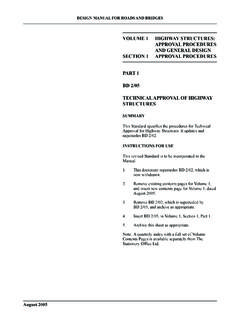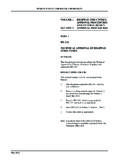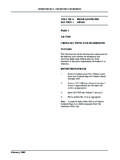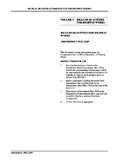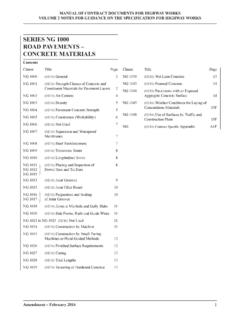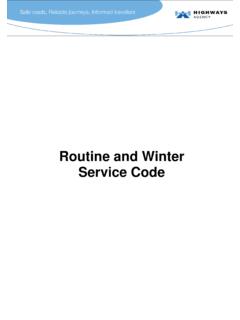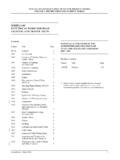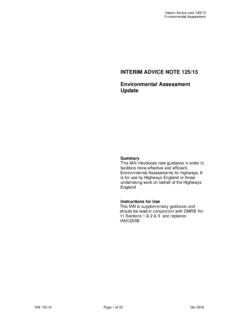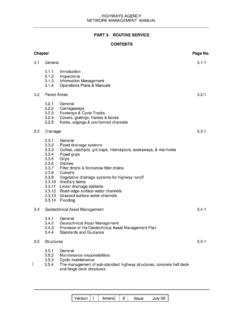Transcription of DMRB VOLUME 3 SECTION 4 PART 3 - Standards …
1 May 2001 DESIGN MANUAL FOR ROADS AND BRIDGESVOLUME 3 highway STRUCTURES:INSPECTION ANDMAINTENANCESECTION 4 ASSESSMENTPART 3BD 21/01 THE assessment OF HIGHWAYBRIDGES AND STRUCTURESSUMMARYThis Standard gives criteria for the assessment ofhighway bridges and structures. It supersedesBD 21 FOR USEThis is a revised document to be incorporated into BD 21/97, which is superseded byBD 21/01 and archive as BD 21/01 into VOLUME 3, SECTION this sheet as : A quarterly index with a full set of VolumeContents Pages is available separately from TheStationery Office Ltd. BD 21/01 The assessment of HighwayBridges and StructuresSummary:This Standard gives criteria for the assessment of highway bridges andstructures. It supersedes BD 21 MANUAL FOR ROADS AND BRIDGES* A Government Department in Northern IrelandTHE HIGHWAYS AGENCYSCOTTISH EXECUTIVE DEVELOPMENT DEPARTMENTTHE NATIONAL ASSEMBLY FOR WALESCYNULLIAD CENEDLAETHOL CYMRUTHE DEPARTMENT FOR REGIONAL DEVELOPMENT* VOLUME 3 SECTION 4 part 3 BD 21/01 May 2001 REGISTRATION OF AMENDMENTSA mendPage NoSignature & Date ofAmendPage NoSignature & Date ofNoincorporation ofNoincorporation ofamendmentsamendmentsRegistration of AmendmentsVolume 3 SECTION 4 part 3 BD 21/01 May 2001 REGISTRATION OF AMENDMENTSA mendPage NoSignature & Date ofAmendPage NoSignature & Date ofNoincorporation ofNoincorporation ofamendmentsamendmentsRegistration of AmendmentsVOLUME 3 highway STRUCTURES:INSPECTION ANDMAINTENANCESECTION 4 ASSESSMENTPART 3BD 21/01 THE assessment OF HIGHWAYBRIDGES AND for and of of of , Foundations and for Restricted.
2 AAW Vehicle and Axle WeightsBIncrease in Loading Due to Centrifugal ActionCProperties of MaterialsDLoading from VehiclesEFire EnginesFAxles Weights for Restricted assessment LiveLoadingsGBackground to Type HA Loading andAssessment Live LoadingHBackground to the Requirements for MasonryArch BridgesJAssessment of bridge Deck Cantilevers forAccidental Wheel LoadingDESIGN MANUAL FOR ROADS AND BRIDGESMay 2001 VOLUME 3 SECTION 4 part 3 BD 21/01 May 20011/1 Chapter 1 Introduction1. Standard, for the assessment of highwaybridges and structures, was prepared in its original formunder the auspices of the Bridges Engineering Divisionof the Department of Transport, by a working partyconsisting of representatives from the followingorganisations at that time:Department of TransportScottish Development DepartmentDepartment of the Environment for NorthernIrelandAssociation of County CouncilsAssociation of Metropolitan AuthoritiesBritish Railways BoardLondon TransportBritish Waterways Standard updates and replaces the 1997version and is to be used in conjunction with thecomplementary Advice Note BA 16 ( dmrb ).
3 Although the latter is advisory in nature, the principlesand methods given in it may be deemed to satisfy therelevant criteria in the Standard. Throughout theStandard reference has been made to appropriate BritishStandards. Where trunk road structures are to beassessed this Standard should be used in conjunctionwith the other documents contained in VOLUME 3, SECTION 4 of the Design Manual for Roads and non-trunk road structures the followingimplementation documents may be considered as beingparticularly relevant:(i)BD 34 ( dmrb )(ii)BA 34 ( dmrb )(iii)BD 46 ( dmrb )(iv)BD 50 ( dmrb )(v)BA 79 ( dmrb ) the assessment of any bridge or structureshows it to be inadequate, then the following actionsshall be taken:(i)Consider the Interim Measures described in BA79 ( dmrb ). If the structure is not deemedmonitoring-appropriate, then vehicle weight and/or lane restrictions, calculated in accordance withChapter 9 of this Standard, shall be applied onthe bridge or the bridge shall be propped;(ii)If it is considered that further deterioration of thestructure may occur in spite of vehicle weightand/or lane restrictions, the condition of thebridge shall be monitored by Special Inspectionsat intervals not exceeding six months, inaccordance with the documents contained inVolume 3, SECTION 1 of the Design Manual forRoads and Bridges ( dmrb );(iii)Replacement or strengthening of the structure tocarry full design loading, should be undertakenwithout undue delay (for trunk road bridges andstructures in accordance with the documentscontained in VOLUME 3, SECTION 4 of the DesignManual for Roads and Bridges ( dmrb )).
4 If, in the course of an assessment , a structure is found tobe so inadequate that there is an immediate risk topublic safety, the procedure described in BA 79( dmrb ) regarding action for Immediate RiskStructures shall be timing of the replacement or strengtheningof a weak structure will depend on the VOLUME andweight of traffic normally carried by it, and the effect ofthe traffic restriction on the general transport networkin the neighbourhood. If alternative unrestrictedcrossings are available without involving undue delaysor detours, then the replacement/strengthening may bepostponed. There may indeed be cases where the cost ofreplacement/strengthening would represent poor value,and where it would be better to leave the trafficrestrictions in force until such time as replacement/strengthening is justified from a value-for-moneyassessment. However, imposition of any trafficrestriction on a particular crossing will increase thevolume of traffic on, and hence accelerate thedeterioration of, the alternative routes and should be taken into account in programming forreplacement/strengthening of the weak of the bridges to be assessed by thisStandard are of considerable age and representimportant features of our cultural heritage.
5 Theirsurvival to this day owes a great deal to the care of pastgenerations. Where remedial or strengthening works arefound to be necessary, the proposals should reflect theVolume 3 SECTION 4 part 3 BD 21/01 May 20011/2 Chapter 1 Introductionduty to retain the character of these structures for thebenefit of future generations. Early remedial measures,which restore the carrying capacity and extend the lifeof these structures, are preferable to urgentreconstruction, as the former not only prove generallyto be more cost-effective, but also retain the existingcharacter of these Standard is intended to be used for theassessment of highway bridges and structures builtprior to 1922*, in addition to bridges and structuresbuilt after 1922 which were not designed for theequivalent of 30 units of HB loading. It can also beapplied to any post-1922 bridge which is thought eitherto have a reduced loading capacity as a result ofdeterioration or damage, or to have been designed tosub-standard criteria.
6 *Note: The first government loading for highwaybridges was introduced in 1922 and the first BritishStandard on loading was published in 1929. This wasfollowed in 1931 by a revised British Standardcontaining the familiar equivalent uniformly distributedloading curve. HB type loading (or its equivalent) wasintroduced in the post-war Standard covers the assessment of bridgesconstructed of steel, concrete, wrought iron and castiron, as well as the assessment of brick and stonemasonry arches. It does not cover timber structures orstone slab bridge decks. It also covers the assessment ofspandrel walls, sub-structures, foundations, wing walls,retaining walls, dry-stone walls, and buried concretebox Standard adopts the limit state format withpartial safety factors, although there are exceptions inthe cases of cast iron construction, and brick and stonemasonry Type HA (design) loading given in thisStandard allows for the effects of 40 tonne vehicles andincludes a contingency margin for unforeseeablechanges in traffic patterns.
7 For assessment , reductionfactors are applied to the Type HA loading to give thevarious assessment Live Loading levels with nocontingency provision. The 40 tonnes assessment LiveLoading covers the effects of vehicles of up to40 tonnes gross vehicle weight (including 41 tonnes6 axles lorries, 44 tonnes 6 axles bimodal articulatedlorries and draw bar trailer combinations and, 44 tonnes6 axle general haulage lorries, see Annex A) tonnes axle weight. For cases where structures arefound to be incapable of carrying the full 40 tonnesAssessment Live Loading, loading criteria are givenwhich correspond to specified limits on gross vehicleweights. Special loading criteria are also given for limits are currently contained in two setsof Regulations The Road Vehicles (AuthorisedWeight) Regulations 1998 (SI 1998/3111) as amendedand The Construction and Use (C&U) Regulations1996 as amended. The AW Regulations will beexpanded in due course to cover all motor vehicles andtrailers and replace the weight limits in the C&URegulations.
8 But, until the changeover takes place, thetwo sets of Regulations will run side by side. Forconvenience this Standard mainly refers to only AWRegulations. If there are further amendments affectingthe allowable weights and dimensions of vehicles andaxles, this Standard will be amended as necessary. InNorthern Ireland the corresponding sets of Regulationsare The Motor Vehicles (Authorised Weight)Regulations (Northern Ireland) 1999 and The MotorVehicles (Construction and Use) Regulations (NI) arch assessment this Standard is intended tobe used in conjunction with Advice Note BA 16( dmrb ), which contains a description of anacceptable method of arch assessment based on theMEXE method. The Advice Note also containssimplified methods of load distribution for certain typesof bridge construction, advice on the assessment of drystone walls, retaining walls, sub-structures andfoundations, and some general guidance onmaintenance and repair of older types of Standard shall be used forthwith forassessments of load carrying capacity of trunk roadbridges and other structures, including those structurescurrently being assessed, provided that, in the opinionof the Overseeing Organisation, this would not result insignificant additional expense or delay progress.
9 Itsapplication to particular assessment should beconfirmed with the Overseeing 3 SECTION 4 part 3 BD 21/01 May the purpose of this Standard the followingdefinitions apply:(i) assessment . Inspections and determination ofload carrying capacity of a structure in termsof either full AW loading or specified grossvehicle weights.(ii) assessment Live Loading. Loads from AW orother specified vehicles as described in (iii) assessment Loads. Loads determined forassessment of the structure by applying thepartial factors for load, fL, to the nominalloads.(iv) assessment Load Effects. Load effectsdetermined by applying the partial factor forload effect, f3 , to the effects of theassessment loads.(v) assessment Resistance. The resistancedetermined by application of a ConditionFactor to the calculated resistance.(vi)Arch Barrel. The single structural archelement formed by one or more arch rings.(vii)Arch Ring. A single ring of bricks or stones ofapproximately even size formed to an archprofile.
10 (viii)Authorised Weight (AW) governing weights for the use ofnormal vehicles on the highway - see (ix)Bearing. The structural component used totransmit loading from the superstructure to thesubstructure.(x)Bedding. Mortar and other material under thebaseplate of a bearing.(xi)Bogie. Two or three closely spaced or adjacent axles.(xii)Calculated Resistance. The capacity of thestructure or element determined from materialstrengths and sections properties byapplications of partial factor for materialstrength, m.(xiii)Centrifugal Effects. Radial forces and changesto vertical live loading due to vehiclestravelling in a horizontally curved path.(xiv)Condition Factor. Factor which accounts fordeficiency in the integrity of the structure asdescribed in (xv)Construction and Use (C&U) governing weights for the use ofnormal vehicles on the highway - see (xvi)Dead Load. Loading due to the weight of thematerials forming the structure or structuralelements but excluding superimposed deadload materials.

